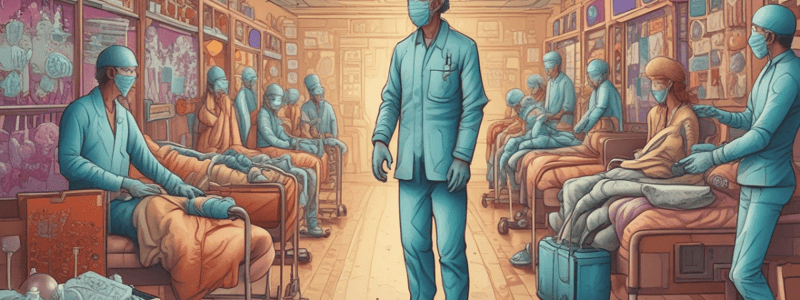Podcast
Questions and Answers
What is the clinical feature that distinguishes aseptic meningitis from bacterial meningitis?
What is the clinical feature that distinguishes aseptic meningitis from bacterial meningitis?
- Positive CSF gram stain
- Presence of fever
- Altered mental status
- Normal cerebral function (correct)
Which virus is a leading cause of viral meningitis from the Picornaviridae family?
Which virus is a leading cause of viral meningitis from the Picornaviridae family?
- HSV2
- Rhinovirus
- Enterovirus 71 (correct)
- Arbovirus
What is a common symptom of acute meningitis characterized by headache, neck stiffness, vomiting, and photophobia?
What is a common symptom of acute meningitis characterized by headache, neck stiffness, vomiting, and photophobia?
- Confusion
- Rash
- Lethargy
- Coma (correct)
Which population is most susceptible to viral infections causing aseptic meningitis?
Which population is most susceptible to viral infections causing aseptic meningitis?
What parameter in the CSF sample is typically abnormal in cases of bacterial meningitis?
What parameter in the CSF sample is typically abnormal in cases of bacterial meningitis?
Which type of meningitis is described as acute community-acquired with negative CSF gram stain and culture?
Which type of meningitis is described as acute community-acquired with negative CSF gram stain and culture?
Which viral infection causes symptoms such as urinary retention, dysaesthesia, and neuralgia?
Which viral infection causes symptoms such as urinary retention, dysaesthesia, and neuralgia?
Which virus is a member of the Picornaviridae family and primarily targets anterior horn cells?
Which virus is a member of the Picornaviridae family and primarily targets anterior horn cells?
Which of the following is NOT one of the symptoms of viral meningitis mentioned in the text?
Which of the following is NOT one of the symptoms of viral meningitis mentioned in the text?
Which type of viral infection typically shows elevated white blood cell count (WBC), mildly elevated protein, and normal or mildly reduced glucose in diagnostic tests?
Which type of viral infection typically shows elevated white blood cell count (WBC), mildly elevated protein, and normal or mildly reduced glucose in diagnostic tests?
Which country is NOT listed as one where polio transmission has never been interrupted?
Which country is NOT listed as one where polio transmission has never been interrupted?
Which statement accurately describes poliovirus transmission?
Which statement accurately describes poliovirus transmission?
What is the typical duration of the 'minor illness' phase in poliovirus infection?
What is the typical duration of the 'minor illness' phase in poliovirus infection?
Which group is at a significantly higher risk of developing OPV-associated disease?
Which group is at a significantly higher risk of developing OPV-associated disease?
Which phase of poliovirus infection involves the development of type-specific antibodies?
Which phase of poliovirus infection involves the development of type-specific antibodies?
Which of the following is NOT a risk factor for paralysis in poliovirus infection?
Which of the following is NOT a risk factor for paralysis in poliovirus infection?
Which neurological structures are most commonly affected by poliovirus infections?
Which neurological structures are most commonly affected by poliovirus infections?
What percentage of poliovirus infections results in frank paralysis?
What percentage of poliovirus infections results in frank paralysis?
Which of the following complications of polio involves muscle paralysis?
Which of the following complications of polio involves muscle paralysis?
Which of the following viruses is NOT a differential diagnosis for polio?
Which of the following viruses is NOT a differential diagnosis for polio?
Which of the following tests is the gold standard for identifying poliovirus?
Which of the following tests is the gold standard for identifying poliovirus?
Which of the following is NOT a recommended treatment for polio?
Which of the following is NOT a recommended treatment for polio?
Which of the following viruses can cause polio-like permanent paralysis?
Which of the following viruses can cause polio-like permanent paralysis?
Which of the following is NOT a common symptom of polio?
Which of the following is NOT a common symptom of polio?




